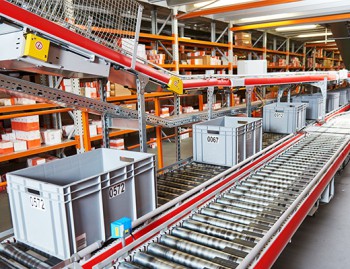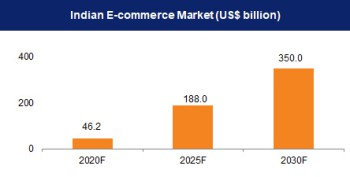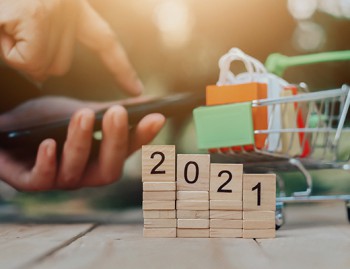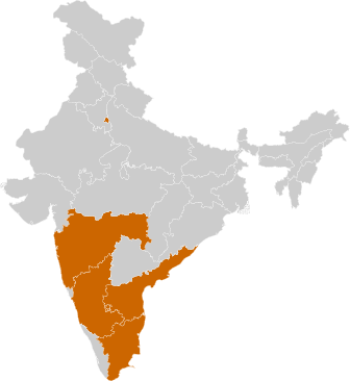INTRODUCTION
E-commerce has transformed the way business is done in India. The Indian E-commerce market is expected to grow to US$ 188 billion by 2025 from US$ 46.2 billion as of 2020. By 2030, it is expected to reach US$ 350 billion. In 2022, the Indian e-commerce market is predicted to increase by 21.5%, reaching US$ 74.8 billion.
India’s e-commerce market is expected to reach US$ 111 billion by 2024 and US$ 200 billion by 2026.
Much of the growth for the industry has been triggered by an increase in internet and smartphone penetration. The number of internet connections in 2021 increased significantly to 830 million, driven by the ‘Digital India’ programme. Out of the total internet connections, ~55% of connections were in urban areas, of which 97% connections were wireless.

MARKET SIZE

The Indian online grocery market is estimated to reach US$ 26.93billion in 2027 from US$ 3.95 billion in FY21, expanding at a CAGR of 33%. India's consumer digital economy is expected to become a US$ 1 trillion market by 2030, growing from US$ 537.5 billion in 2020, driven by strong adoption of online services such as e-commerce and edtech in the country.
According to Grant Thornton, e-commerce in India is expected to be worth US$ 188 billion by 2025.
With a turnover of $50 billion in 2020, India became the eighth-largest market for e-commerce, trailing France and a position ahead of Canada.
Propelled by rising smartphone penetration, launch of 4G network and increasing consumer wealth, the Indian E-commerce market is expected to grow to US$ 200 billion by 2026 from US$ 38.5 billion in 2017.
After China and the US, India had the third-largest online shopper base of 140 million in 2020.
Indian consumers are increasingly adopting 5G smartphones even before roll out of the next-gen mobile broadband technology in the country. Smartphone shipments reached 169 million in 2021 with 5G shipments registered a growth of 555% year on year in 2021. Indian consumers are increasingly adopting 5G smartphones even before roll out of the next-gen mobile broadband technology in the country. Smartphone shipments reached 150 million units and 5G smartphone shipments crossed 4 million in 2020, driven by high consumer demand post-lockdown. According to a report published by IAMAI and Kantar Research, India internet users are expected to reach 900 million by 2025 from ~622 million internet users in 2020, increasing at a CAGR of 45% until 2025.
For the 2021 festive season, Indian e-commerce platforms generated sales worth US$ 9.2 billion Gross Merchandise Value (GMV), a 23% increase from last year’s US$ 7.4 billion.
INVESTMENTS
Some of the major developments in the Indian e-commerce sector are as follows:
- India’s ecommerce sector received US$ 15 billion of PE/VC investments in 2021 which is a 5.4 times increase year on year. This is the highest investment value received by any sector ever in India.
- In February 2022, Xpressbees became a unicorn with a US$ 1.2 billion valuation after raising US$ 300 million in its Series F funding.
- In Februrary 2022, Amazon India launched One district One product (ODOP) bazaar on its platform to support MSMEs.
- In Februrary 2022, Flipkart launched the “sell back program” to enable trade in smartphones.
- In Janaury 2022, Walmart invites Indian sellers to join its US market place with an aim of exporting US$ 10 billion from India each year by 2027.
- In January 2022, Flipkart has announced expansion in its grocery services and will offer services to 1,800 Indian cities.
- In November 2021, XPDEL US- based ecommerce announced expansion in India.
- In September 2021, CARS24, India's leading used car e-commerce platform, has raised US$ 450 million in funding, comprising a US$ 340 million Series F equity round and US$ 110 million in debt from various financial institutions. In September 2021, Amazon launched Prime Video Channels in India. Prime Video Channels will give Prime members a seamless experience and access to a variety of popular video streaming services.
- In September 2021, Bikayi, a mobile commerce enabler, raised US$ 10.8 million in a Series A funding round, led by Sequoia Capital India.
- Flipkart, India's e-commerce powerhouse, announced in July 2021 that it has raised US$ 3.6 billion in new funding from various sources including sovereign funds, private equities and Walmart (parent company).
- In June 2021, Flipkart added a new fulfilment centre (FC) in Dankuni, West Bengal. The FC is spread over 2.2 lakh sq. ft. and has a potential to create ~3,500 direct jobs.
- In June 2021, Grofers, the grocery delivery start-up, reportedly entered the unicorn club, after raising US$ 120 million from Zomato, the food delivery platform.
- In June 2021, Mastercard invested an undisclosed amount in Instamojo, a payments firm, to help digitise online stores and process their payments more seamlessly.
- In May 2021, Amazon introduced a video streaming service within its shopping app called MiniTV for users in India. MiniTV features web series, comedy shows and content on tech news, food, beauty and fashion.
- In May 2021, Flipkart strengthened its grocery infrastructure to cater to customer safety and demand across India. In this quarter, it is planning to further expand its fulfilment centre capacity for grocery by over 8 lakh square feet across Delhi, Kolkata, Chennai, Coimbatore and Hyderabad..
- In May 2021, Flipkart announced that it is in talks with sovereign funds, private equity majors and other investors to raise up to US$ 2 billion at a valuation of US$ 30 billion.
- In April 2021, Flipkart announced a commercial alliance with Adani Group to improve the company's logistics and data centre capabilities and create about 2,500 direct jobs.
- In April 2021, Flipkart announced to acquire Cleartrip, an online travel technology firm. Flipkart announced to purchase 100% shareholding of Cleartrip as the company expands its investments to broaden its digital commerce offerings for customers.
- In April 2021, Kirana commerce platform ElasticRun raised US$ 75 million in a round led by existing investors—Avataar Venture Partners and Prosus Ventures.
- In March 2021, Amazon acquired Bengaluru-based retail tech start-up Perpule for Rs. 107.6 crore (US$ 14.5 million).
- In March 2021, Purplle, an online beauty store, raised US$ 45 million from Sequoia Capital India, Verlinvest, Blume Ventures and JSW Ventures.
- In March 2021, Captain Fresh, a B2B marketplace for seafood, raised US$ 3 million in seed capital led by Matrix Partners India and Ankur Capital.
- In March 2021, the Confederation of All India Traders (CAIT), which represents 80 million traders and 40,000 trader associations, announced the launch of a mobile app for its e-commerce portal, ‘Bharat E-market’. The association aims to get more small traders to sell online easily through smartphones.
GOVERNMENT INITIATIVES
Since 2014, the Government of India has announced various initiatives, namely Digital India, Make in India, Start-up India, Skill India and Innovation Fund. The timely and effective implementation of such programs will likely support growth of E-commerce in the country. Some of the major initiatives taken by the Government to promote E-commerce in India are as follows:
- As of February 15, 2022, the Government e-Marketplace (GeM) portal served 9.04 million orders worth Rs. 193,265 crore (US$ 25.65 billion) to 58,058 buyers from 3.79 million registered sellers and service providers.
- As of November 2, 2021, the Government e-Marketplace (GeM) portal served 7.96 million orders worth Rs. 152,315 crore (US$ 20.40 billion) to 55,433 buyers from 3.06 million registered sellers and service providers.
- As of October 11, 2021, the Government e-Marketplace (GeM) portal served 7.78 million orders worth Rs. 145,583 crore (US$ 19.29 billion) to 54,962 buyers from 2.92 million registered sellers and service providers.
- In a bid to systematise the onboarding process of retailers on e-commerce platforms, the Department for Promotion of Industry and Internal Trade (DPIIT) is reportedly planning to utilise the Open Network for Digital Commerce (ONDC) to set protocols for cataloguing, vendor discovery and price discovery. The department aims to provide equal opportunities to all marketplace players to make optimum use of the e-commerce ecosystem in the larger interest of the country and its citizen.
- National Retail Policy: The government had identified five areas in its proposed national retail policy—ease of doing business, rationalisation of the licence process, digitisation of retail, focus on reforms and an open network for digital commerce—stating that offline retail and e-commerce need to be administered in an integral manner.
- The Consumer Protection (e-commerce) Rules 2020 notified by the Consumer Affairs Ministry in July directed e-commerce companies to display the country of origin alongside the product listings. In addition, the companies will also have to reveal parameters that go behind determining product listings on their platforms.
- Government e-Marketplace (GeM) signed a Memorandum of Understanding (MoU) with Union Bank of India to facilitate a cashless, paperless and transparent payment system for an array of services in October 2019.
- Under the Digital India movement, Government launched various initiatives like Umang, Start-up India Portal, Bharat Interface for Money (BHIM) etc. to boost digitisation.
- In October 2020, Minister of Commerce and Industry, Mr. Piyush Goyal invited start-ups to register at public procurement portal, GeM, and offer goods and services to government organisations and PSUs.
- In October 2020, amending the equalisation levy rules of 2016, the government mandated foreign companies operating e-commerce platforms in India to have permanent account numbers (PAN). It imposed a 2% tax in the FY21 budget on the sale of goods or delivery of services through a non-resident ecommerce operator.
- In order to increase the participation of foreign players in E-commerce, Indian Government hiked the limit of FDI in E-commerce marketplace model to up to 100% (in B2B models).
- Heavy investment made by the Government in rolling out fiber network for 5G will help boost E-commerce in India.
ROAD AHEAD
The E-commerce industry has been directly impacting micro, small & medium enterprises (MSME) in India by providing means of financing, technology and training and has a favourable cascading effect on other industries as well. Indian E-commerce industry has been on an upward growth trajectory and is expected to surpass the US to become the second largest E-commerce market in the world by 2034. Technology enabled innovations like digital payments, hyper-local logistics, analytics driven customer engagement and digital advertisements will likely support the growth in the sector. The growth in E-commerce sector will also boost employment, increase revenues from export, increase tax collection by exchequers, and provide better products and services to customers in the long-term. Rise in smartphone usage is expected to rise 84% to reach 859 million by 2022.
E-retail market is expected to continue its strong growth - it registered a CAGR of over 35% to reach Rs. 1.8 trillion (US$ 25.75 billion) in FY20. Over the next five years, the Indian e-retail industry is projected to exceed ~300-350 million shoppers, propelling the online Gross Merchandise Value (GMV) to US$ 100-120 billion by 2025.
According to Bain & Company report, India’s social commerce gross merchandise value (GMV) stood at ~US$ 2 billion in 2020. By 2025, it is expected to reach US$ 20 billion, with a potentially monumental jump to US$ 70 billion by 2030, owing to high mobile usage.

References: Media Reports, Press releases, Business Standard, Economic Times, LiveMint, Times Now, Times of India
Disclaimer:This information has been collected through secondary research and IBEF is not responsible for any errors in the same
Major Hubs for Ecommerce
- Karanataka
- Delhi
- Maharashtra
- Tamil Nadu
- Andhra Pradesh

Industry Contacts
- The E-Business council of India (TECI)
- Retailers Association of India (RAI)